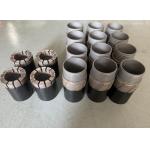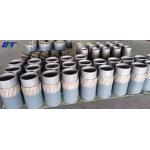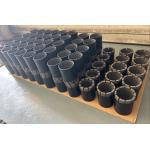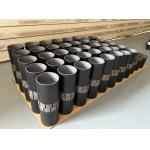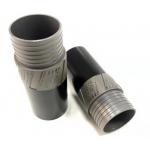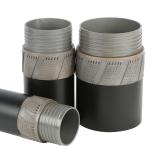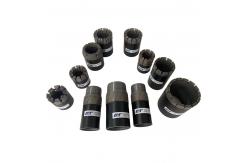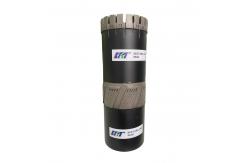Diamond Reaming Shell with Straight Impregnation Pattern for
Optimum Cuttings Removal Description about the diamond reaming shell: Reaming Shell Design Variations: Diamond reaming shells are
available in various design variations to accommodate different
drilling conditions and objectives. These variations include
different diamond impregnation patterns, such as straight, spiral,
or staggered, which affect the cutting efficiency and debris
removal capabilities of the shell. Cuttings Removal: The diamond reaming shell is designed to
efficiently remove the cuttings generated during drilling. The
shell's design incorporates flutes or channels that allow the
cuttings to be transported to the surface through the annular space
between the borehole wall and the drill string. Effective cuttings
removal helps maintain borehole stability and prevents clogging of
the drilling operation. Reaming Shell Materials: While the steel body is a common
construction material for diamond reaming shells, other materials
can be used depending on the drilling requirements. For example,
non-magnetic alloys may be used in situations where magnetic
interference needs to be minimized, such as in geophysical or
directional drilling applications. Reaming Shell Advancement Techniques: The diamond reaming shell can
be advanced through different techniques, depending on the drilling
conditions and equipment available. Common techniques include
rotary drilling, where the shell is rotated using the drill string,
and rotary-percussion drilling, which combines rotation and
intermittent percussion to break through harder formations. Reaming Shell Compatibility with Drilling Fluids: The diamond
reaming shell is designed to work in conjunction with drilling
fluids, also known as mud. The drilling fluid helps cool and
lubricate the drill bit and reaming shell, carry the cuttings to
the surface, and provide stability to the borehole. The reaming
shell's design allows for effective circulation and management of
the drilling fluid during the drilling process. Reaming Shell Performance Monitoring: Monitoring the performance of
the diamond reaming shell is important to ensure optimal drilling
efficiency and tool life. Monitoring techniques may include
analyzing the rate of penetration, torque, and weight on bit during
drilling operations. This data helps assess the condition of the
reaming shell and can guide decisions on maintenance or
replacement. Reaming Shell Applications in Directional Drilling: Diamond reaming
shells play a crucial role in directional drilling, which involves
intentionally deviating the wellbore to reach specific targets. The
reaming shell helps maintain borehole stability and size during the
drilling of curved or horizontal sections, enabling accurate
wellbore placement. Reaming Shell Safety Considerations: Safety is a paramount concern
in drilling operations, and the use of a diamond reaming shell
involves adherence to safety protocols. These protocols include
proper training of personnel, the use of personal protective
equipment, and regular inspection of the drilling equipment,
including the reaming shell, to identify any potential hazards or
issues. Reaming Shell Cost Considerations: The cost of diamond reaming
shells varies depending on factors such as size, design complexity,
diamond quality, and the manufacturing process. While the initial
cost may be higher compared to other drilling tools, the long-term
benefits in terms of improved drilling efficiency, reduced
downtime, and extended tool life can outweigh the initial
investment.
The diamond reaming shell continues to be an essential tool in the
drilling industry, enabling efficient and precise drilling
operations in various geological formations. Ongoing advancements
in design, materials, and monitoring techniques contribute to its
effectiveness and reliability in meeting the evolving needs of the
drilling industry. | Reaming classification | | T series | T36,T46,T56,T66,T76,T86 | | Cable series | AWL,BWL,NWL,HWL,PWL(Front end,rear end) | | WT series | RWT,EWT,AWT,BWT,NWT,HWT(single tube/double tube) | | T2/T series | T256,T266,T276,T286,T2101,T676,T686,T6101,T6116,T6131,T6146,T6H | | WF series | HWF,PWF,SWF,UWF,ZWF | | WG series | EWG,AWG,BWG,NWG,HWG(single tube/double tube | | WM series | EWM,AWM,BWM,NWM | | Others | NMLC,HMLC,LTK48,LTK60,TBW,TNW,ATW,BTW,NTW,AQTK
NXD3,NXC,T6H,SK6L146,TT46,TB56,TS116,CHD101 |
FAQ: - Q: Can diamond reaming shells be used in drilling for permafrost
research?
A: Yes, diamond reaming shells can be used in drilling operations
for permafrost research and analysis. - Q: Can diamond reaming shells be used in drilling for waste
disposal facilities?
A: Yes, diamond reaming shells can be used in drilling operations
for waste disposal facility construction. - Q: Can diamond reaming shells be used in drilling for cavern
development?
- A: Yes, diamond reaming shells can be used in drilling operations
for cavern development, such as underground storage caverns.
- Q: Can diamond reaming shells be used in drilling for geothermal
energy projects?
A: Yes, diamond reaming shells can be used in drilling operations
for geothermal energy exploration and well drilling.
|
